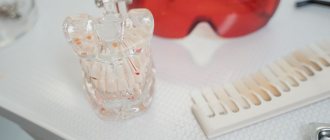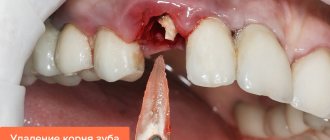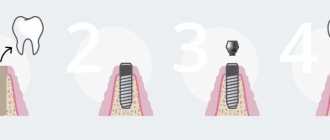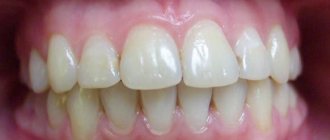We do not just a lot, but a lot of similar operations. People come from other cities, even from other countries, to get rid of annoying eights in Moscow, but we don’t understand why such a simple operation cannot be done in our city.
When asked why they needed to come to us, patients answer that they are afraid to do it anywhere else.
In one clinic they are offered to do everything at once and under anesthesia (which, to put it mildly, is very expensive and very unsafe).
In another, they almost guaranteed a nerve injury with all that it entails. Moreover, it is assumed that this should “distort the face” - pure incompetence and lies.
In the third, they demand to buy biomaterials for the holes - a waste of money and simply a dangerous procedure.
In the fourth medical institution they promised to remove the wisdom tooth in 3-4 hours, bringing this trivial operation in complexity and duration to coronary artery bypass surgery.
Why do you want to have your wisdom teeth removed with us? Because we don't do any of that!
Anesthesia.
To remove even the most difficult wisdom teeth, local anesthesia is sufficient.
Firstly, it is as safe as you can imagine and is suitable for absolutely everyone. Properly administered local anesthesia is at least several hours of persistent pain relief, sufficient to not only remove wisdom teeth, but also perform rhinoplasty and mammoplasty as a gift.
Secondly, local anesthesia has one significant advantage. In our opinion, the most important thing is maintaining verbal and non-verbal contact with the patient. Local anesthesia and preservation of all cognitive functions, at a minimum, eliminate treating the patient like a piece of meat - we feel you, worry with you and strive to cause as little discomfort as possible. A number of researchers have studied the morbidity and incidence of complications, comparing operations under local and general anesthesia, and the results of the studies were far from in favor of the latter. And there is an explanation for this. The lack of reactions on the part of the patient under sedation “frees the hands” of the surgeon; direct and feedback connections are lost between him and the patient - because of this, the traumatic nature of the operation increases sharply.
For local anesthesia when removing wisdom teeth, we use anesthetics familiar to all dentists. Mainly based on Articaine - as the most effective and safe.
How is wisdom tooth extraction performed?
Based on the figure eight state, the dental surgeon chooses a simple or complex surgical intervention algorithm.
Easy removal
It is used in case of a typical location of a wisdom tooth, if its coronal part is sufficiently preserved. For example, the 8th teeth can be removed in this way in case of periodontitis, when damage to the cement leads to their loosening. The duration of the operation is influenced by the structural features and branching of the roots. If there are no difficulties, the procedure takes about 20 minutes.
Sequencing:
- Anamnesis collection. At this stage, a survey is conducted to identify common diseases and contraindications.
- X-ray diagnostics. From the image, the doctor assesses the orientation and condition of the root system.
- Local anesthesia. The type of anesthetic injections for removal is selected taking into account allergic reactions and personal intolerance.
- Using special instruments, the gums are peeled off to prevent soft tissue injury.
- The surgeon rocks the tooth while holding it with forceps. This destroys the ligaments that firmly hold it in the bone.
- Direct tooth extraction.
- If there are bone fragments left in the hole, they are carefully removed.
- After treatment with antiseptics, an anti-inflammatory medicine is placed in the hole.
- If during the operation a large cavity with damaged edges is formed, the wound is sutured.
Difficult removal
When it is not possible to extract a tooth with forceps, you have to resort to a special surgical technique. Candidates for complex removal are impacted and dystopic wisdom teeth. In such situations, they are accessed through an incision in the gum.
Such manipulation causes unreasonable fear in patients, but there is no need to be afraid of it. It is performed quickly and absolutely painlessly. Problem eights that are not removed in time cause much more trouble.
Stages of complex tooth extraction:
- Anesthesia.
- Gum cutting. If the tooth is “hidden” deeply, the mucoperiosteal flap is peeled off.
- A hole is drilled in the jawbone using an ultrasonic instrument or bur.
- The tooth is extracted.
- If the figure eight is large in size, it is divided into parts and each fragment is extracted separately.
- An analgesic and regeneration-accelerating drug is placed into the cavity.
- Stitches are applied.
Nerve damage – is it possible?
I’ll say right away that under general anesthesia it’s absolutely possible. Due to the same increasing morbidity.
The correct technology for removing wisdom teeth does not involve approaching the nerve trunk closer than 5 mm. Correctly formed access, opening and fragmentation of the tooth excludes access for cutting and sawing instruments to the apex of the wisdom tooth root, next to which the nerve usually passes. And during the removal process, you cannot make significant physical efforts, you cannot use a hammer and chisel (unfortunately, this still happens in some places). And then everything will be fine with the nerve.
Rarely, and in some patients, paresthesia still occurs after tooth extraction. It may be due to injury to the nerve trunk during anesthesia or swelling compressing the nerve in the area of surgery. After some time, sensitivity is restored. There has never been a time when she did not recover. It just takes time. Which? Alas, the process of restoring sensitivity takes different times for everyone. Some people need a couple of days, others a couple of months. But paresthesia always goes away - that's a fact.
What don't they tell you when your tooth is removed?
Any person experiencing toothache wants to get rid of a tooth quickly and doctors are delighted when they almost wave a magic wand and make the tooth fly out in a few seconds. But everything is not as simple as it seems at first glance.
Traumatic removal. This is, as a rule, a very quick removal, in which the doctor does not care about what will happen to the patient after, because... This is most likely an on-duty appointment at a free clinic, for which the doctor does not have too much time, and after this there is a queue of 10 of the same patients. What a patient with a missing tooth will do after such an appointment is the patient’s own problem.
After such removal, the bone is very often damaged, after healing, a bone tissue failure forms in the place of the missing tooth, and in the future this person will have to face very great difficulties with dentures. He will not be able to install a normal implant, he will not be able to select a suitable prosthesis so that it is beautiful, aesthetic and functional.
Another problem with such rapid removal is poorly cleaned inflammation inside the socket (cyst, granuloma). Such a hole takes a very long time to heal and bothers its owner. And even years later, the hole never fully heals. Therefore, quick deletions do not create good consequences in most cases.
During atraumatic removal, the doctor always thinks not only about how to remove the tooth, but also how to remove the tooth so that in the future, when the bone heals, it does not lose volume. This is the main task. Because after some time, maybe in a year or five years, a person will want to get an implant or other types of prosthetics, and for this it is necessary that the place where the tooth was once located has a certain shape. And a doctor who removes a tooth in an atraumatic way always pursues the following tasks:
- calculate how to remove a tooth so as not to break the bone socket; — how to reduce soft tissue damage to a minimum; — how to create such conditions after removal so that the hole heals as quickly as possible and does not sag in the bone.
This procedure is more complicated and more expensive than traumatic removal, but let’s try to do the math together. Atraumatic removal in our clinic starts from 6,000 rubles versus 1,000 in some other clinic. You overpay 5,000 rubles now, but save 30,000 rubles in the future on bone augmentation operations when you want to have prosthetics with implants. You don’t have to waste your time and nerves, and that’s the most important thing, don’t you think?
Book a consultation with our surgeon right now and you will save money!
Why do you need to place an artificial bone in the figure eight hole?
The purpose of this procedure is one thing - to shake out more money from you, otherwise the doctor has a car loan and a mortgage. Even the most expensive biomaterials placed in the sockets of wisdom teeth do not play any useful role; their use does not carry any meaningful meaning. But it can be worse - they often fester and complicate the course of the postoperative period, leading to very sad consequences. In other words, you cannot use “artificial bone” when removing a wisdom tooth. Even if you really want to.
The most we use are collagen sponges soaked in anti-inflammatory compounds. They help stop socket bleeding and minimize inflammatory symptoms (primarily pain) immediately after removal. And they stand... they cost almost nothing.
Indications for wisdom tooth removal
1. Dental dystopia.
The highest percentage of complications is caused by atypically growing wisdom teeth. Dystopia manifests itself as a deviation from the normal position. A common cause of dystopic third molars is lack of sufficient space. Eights are massive and require a lot of space for proper placement, and modern humans have relatively compact jaws.
As a result of the uneven growth of eights, the following negative situations arise:
- Chronic cheek injury (erosions, ulcers, hyperkeratosis).
- Hidden caries.
- Formation of periodontal pockets.
- Disorders of the mandibular joint.
2. Tooth retention.
When unerupted third molars exist under the gum, they are called impacted. If they erupt partially, they are semi-retinated. With complete retention, the figure eight may not bother its owner, and it is accidentally detected on an x-ray.
Partial retention is fraught with unpleasant consequences, including:
- Inflammation of the gingival hood;
- Periostitis (flux);
- Tooth cyst;
- Hidden caries.
Third molars can exert pressure on neighboring teeth, which is transmitted along the “chain” along the entire row. Sometimes even the incisors become deformed due to their fault. The growth of impacted eights displaces teeth after orthodontic correction. Therefore, before treatment with an orthodontist, it is advisable to get rid of them.
Other reasons.
- Normally erupted third molars are removed for the same reasons as the remaining teeth:
- Presence of perihilar cysts;
- Volumetric destruction of the crown or root system that is not subject to therapeutic treatment;
- Mobility 2-3 degrees;
- Injury.
When the likelihood of successful treatment is low and the doctor may suggest tooth extraction
Examples of a less favorable situation:
1) The crown of the tooth is severely damaged. All that was left of the tooth was the root. This means that the tooth will have to be restored with a crown on the stump tab.
tooth restoration with a core inlay and crown
You will find more detailed information in the article What guides a dentist when he suggests restoring a tooth: with a filling, inlay, veneer or crown?
2) The x-ray shows significant destruction of bone tissue. This means that bone restoration will take longer and worse.
3) Root canals have a complex shape and removing all the infected pulp (“dental nerve”) from them is a difficult task.
4) The roots of the tooth are thin and curved. Expansion of the canals when removing infection from them can lead to the fact that the walls of the tooth cannot withstand the chewing load.
There are many difficulties in endodontic treatment; it is not for nothing that this area of dentistry is considered one of the most difficult. In the article Why you can’t give a 100% guarantee on tooth root canal treatment, we talk in detail about the difficulties of endodontic treatment, but here we will only demonstrate what a bizarre shape canals can be.
shape of the canals of the teeth of the upper and lower jaw
5) The tooth canals were previously filled. Canal retreatment is the “highest aerobatics” in endodontic treatment. It is not always possible to even unseal them. Sometimes this treatment leads to tooth extraction.
6) After unsuccessful endodontic treatment, a pin or a fragment of an instrument is fixed in the root canal. Removing foreign bodies from canals is a complex procedure with an unknown result.
7) Several teeth are missing in the oral cavity and an increased load is placed on the diseased tooth. Any depulped (“dead”) tooth copes with its function worse, since after removal of the “nerve” it becomes more fragile.
 The presence of granuloma and cyst further weakens the tooth.
The presence of granuloma and cyst further weakens the tooth.
9) The tooth periodically worries and the patient is “tired” of it.
10) The patient has concomitant diseases. And since any chronic disease weakens the immune system, the likelihood of successful treatment decreases.
The indication for tooth extraction may be one or more of the listed reasons.
Actions after removal
It is necessary to monitor the patient's condition for several days.
Negative manifestations if:
- The wound bleeds an hour after removal;
- There is clouding of consciousness;
- The person has a fever;
- The pain has become pulsating in nature - an urgent examination by a dentist is necessary, as a jaw injury is possible.
The difference in how to pull out a molar at home or a baby tooth is only in the length of the roots. To minimize negative consequences, it is necessary to work in gloves treated with an antiseptic composition.










